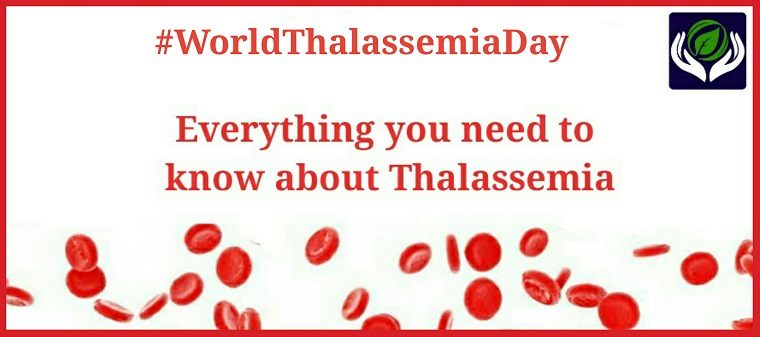
World Thalassemia Day: Everything you need to know about Thalassemia.
What is Thalassemia?
Thalassemia is a blood disorder passed down through families characterized by less hemoglobin and fewer red blood cells in your body than normal. Hemoglobin is a protein found in red blood cells and carries oxygen to all parts of the body. Disease results in large numbers of red blood cells being destroyed and oxygen cannot get to all parts of the body. Organs become starved for oxygen, as a result are not able to work properly.
Causes of Thalassemia
It is caused either
- By mutations in the DNA of cells that make hemoglobin.
- Deletion of certain key gene fragments.
Thalassemia is a genetic disease, that means at least one of your parents must be a carrier of this disorder.
Types of Thalassemia
Hemoglobin is made of 2 proteins called Alpha globin and Beta globin. The type of thalassemia you have depends on the number of gene mutations you inherit from your parents and which part of the hemoglobin molecule is affected by the mutations.
Alpha Thalassemia: –
Formation of alpha hemoglobin chain involves 4 genes ( two from each of your parents).
- If one gene is mutated, you are just a carrier of this disease and will pass it to your offspring.
- If two genes are mutated, you will experience signs and symptoms will be mild.
- If three genes are mutated, you will experience mild to moderate signs and symptoms.
- If four genes are mutated, it is a rare and severe condition which needs bone marrow transplantation.
Beta Thalassemia –
Formation of beta hemoglobin chain involves 2 genes ( one from each of your parents)
- If one gene is mutated, signs and symptoms will be mild leading to the condition is called Thalassemia Minor.
- If two genes are mutated, signs and symptoms are moderate to severe leading to Thalassemia Major.
Signs and Symptoms of Thalassemia
Severe Anemia – Infants are normal at birth but moderate to severe anemia start appearing from 6 to 9 months.
Retarded Growth – Anemia can cause a growth of a child to slow.
Changes in Bone – Bone marrow expansion leads to bone structure abnormalities particularly in skull and face. This expansion also makes bones thin and fragile leading to increased chances of their breakage.
Enlargement of spleen – In Thalassemia spleen tends to enlarge and work harder than normal. Spleen works to fight infection and remove the old and damaged blood cells.
Iron overload – Due to frequent blood transfusion iron deposits are increased. It damages organs like heart, liver and pancreas.
Diagnosis and Investigations for Thalassemia
- A complete blood test.
- Peripheral blood smear.
If your child has Thalassemia, the test will result in
- RBC number will be decreased.
- The shape of RBCs will be abnormal with uneven distribution of hemoglobin.
- Size of RBCs will be smaller than expected.
- DNA analysis can be done to diagnose thalassemia or to determine if one is carrying mutated hemoglobin genes or not.
Prevention of Thalassemia
Being a genetic disease, there is no door to prevention. However, all couples planning on becoming parents can be tested to see if they have thalassemia. Families carrying Thalassemia trait should go for genetic counselling and testing.
Testing for prenatal diagnosis are:-
- Chorionic villus sampling
- Amniocentesis.
Management of Thalassemia
Diet changes:-
- Limit Iron foods – avoid taking fortified foods which contain iron, stop taking any supplements containing iron, limit fish and meat.
- Start having a plant-based low-fat diet.
- To keep bones strong, make sure your diet contains enough calcium and vitamin D.
Lifestyle modifications:-
- Avoid doing any type of heavy exercise.
- Take care you avoid any type of infection. Avoid meeting sick people and frequently wash your hands. In case of fever or infection talk to your doctor.
Treatment of Thalassemia
- Frequent blood transplantation – overtime transfusions can cause iron overload which can damage vital organs.
- Bone marrow transplantation – it can eliminate the need for blood transfusion and medicines to compensate iron overload. Untreated children fail to grow and this disease can be fatal within 4 to 5 years due to anemia. Treated patients can survive for beyond 40 years.
- So it’s better to diagnose as early as possible.
Note the symptoms if your child is facing paleness, failure to grow, poor appetite, frequent infections then get a free consultation from Homeo Solutions for your child for his better health.
